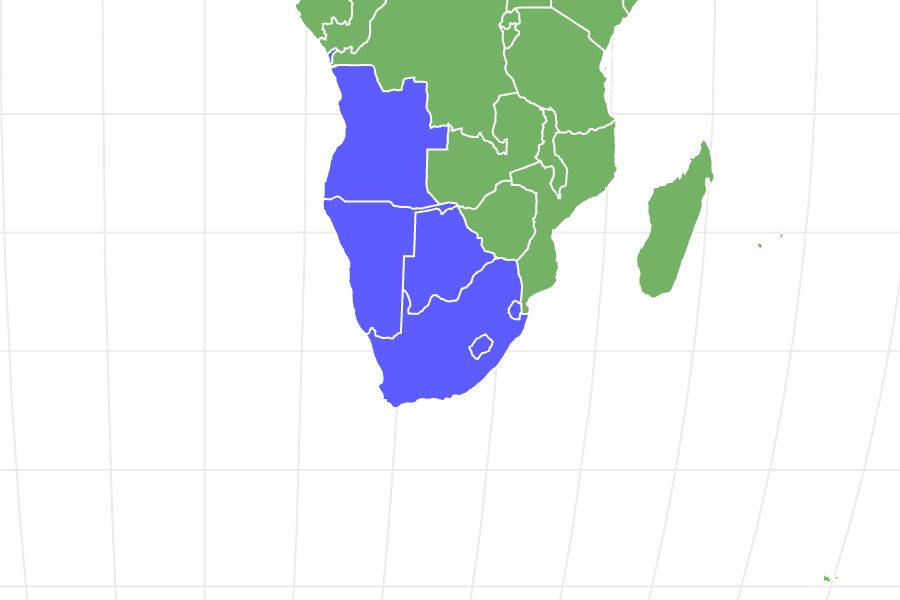Springbok
Antidorcas marsupialis
Springboks derive so much water from their food they could go their entire lives without drinking from large sources of water.
Advertisement
Springbok Scientific Classification
- Kingdom
- Animalia
- Phylum
- Chordata
- Class
- Mammalia
- Order
- Artiodactyla
- Family
- Bovidae
- Genus
- Antidorcas
- Scientific Name
- Antidorcas marsupialis
Read our Complete Guide to Classification of Animals.
Springbok Conservation Status
Springbok Facts
- Name Of Young
- Calves
- Group Behavior
- Herd
- Fun Fact
- Springboks derive so much water from their food they could go their entire lives without drinking from large sources of water.
- Estimated Population Size
- Up to 2.5 million
- Biggest Threat
- Hunting
- Most Distinctive Feature
- Large curved horns on the top of the head
- Gestation Period
- 4-6 months
- Litter Size
- 1-2 calves
- Habitat
- Savannas and deserts
- Predators
- Cheetahs, lions, leopards, hyenas, caracals, jackals, wild dogs, and eagles
- Diet
- Herbivore
- Favorite Food
- Grasses, leaves, and flowers
- Type
- Mammal
- Common Name
- Springbok
- Number Of Species
- 1
- Location
- Southern Africa
Springbok Physical Characteristics
- Color
- Brown
- Black
- White
- Skin Type
- Hair
- Top Speed
- 55 mph
- Lifespan
- 7-9 years
- Weight
- 27-48 kg (59-106 lbs)
- Height
- 69-87 cm (27-34 in)
- Length
- 1-1.5 m (4-4.5 ft)
- Age of Sexual Maturity
- 200-400 days
- Age of Weaning
- 4 months
View all of the Springbok images!
The springbok is a medium-sized antelope that roams across the African savanna in massive herds, protected from predators by sheer numbers.
The springbok is one of southern Africa‘s most well-known animals. Although it has similarities to deer, the springbok belongs to the same bovid family as the sheep and cow. This antelope is a very popular attraction in African parks and reserves, with many hoping to witness springboks pronking — performing an energetic, acrobatic series of jumps that can lift them up to 11 feet in the air.
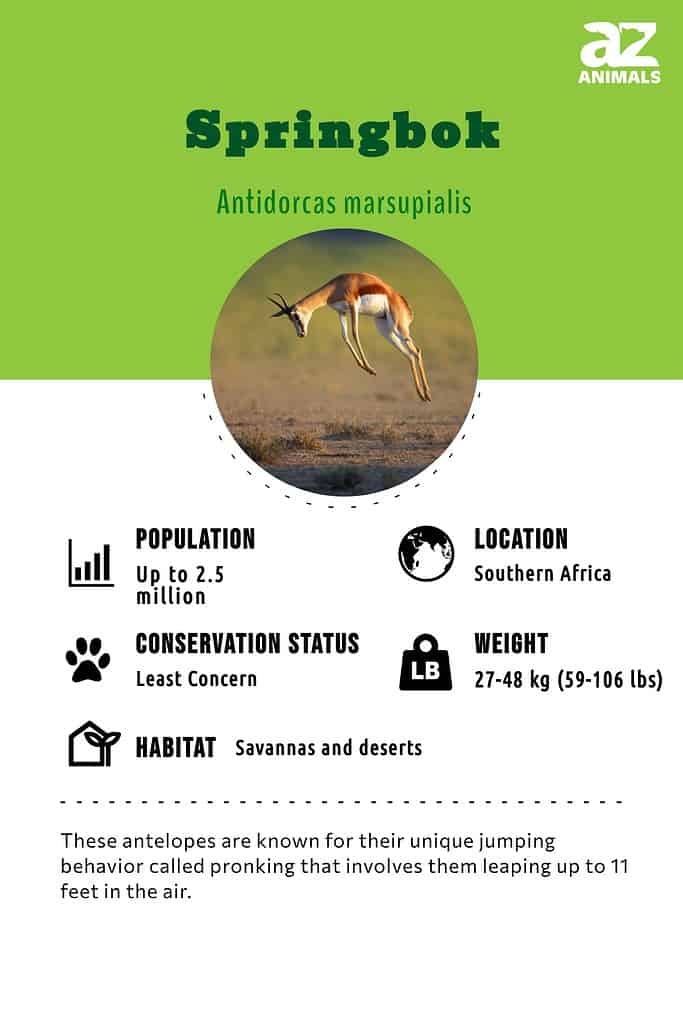
4 Incredible Springbok Facts!
- The name of the springbok derives from two Afrikaans words that mean jump (spring) and antelope (bok). Afrikaans is a Germanic language spoken by Dutch settlers who began arriving in the 17th and 18th centuries.
- The springbok has been an important symbol of the South Africa rugby team and the government since the early 20th century. Due to its association with the country’s history of racial discrimination and segregation, this symbol became a source of controversy following the end of the apartheid government in the early 1990s. However, Nelson Mandela intervened personally to keep the springbok going as a sign of comity with white Afrikaners.
- The springbok can achieve top speeds of around 55 miles per hour. While faster than most animals, it cannot outrun a determined cheetah.
- The male springbok is usually called a ram, while the female is called a ewe. The name for the young is a calf.
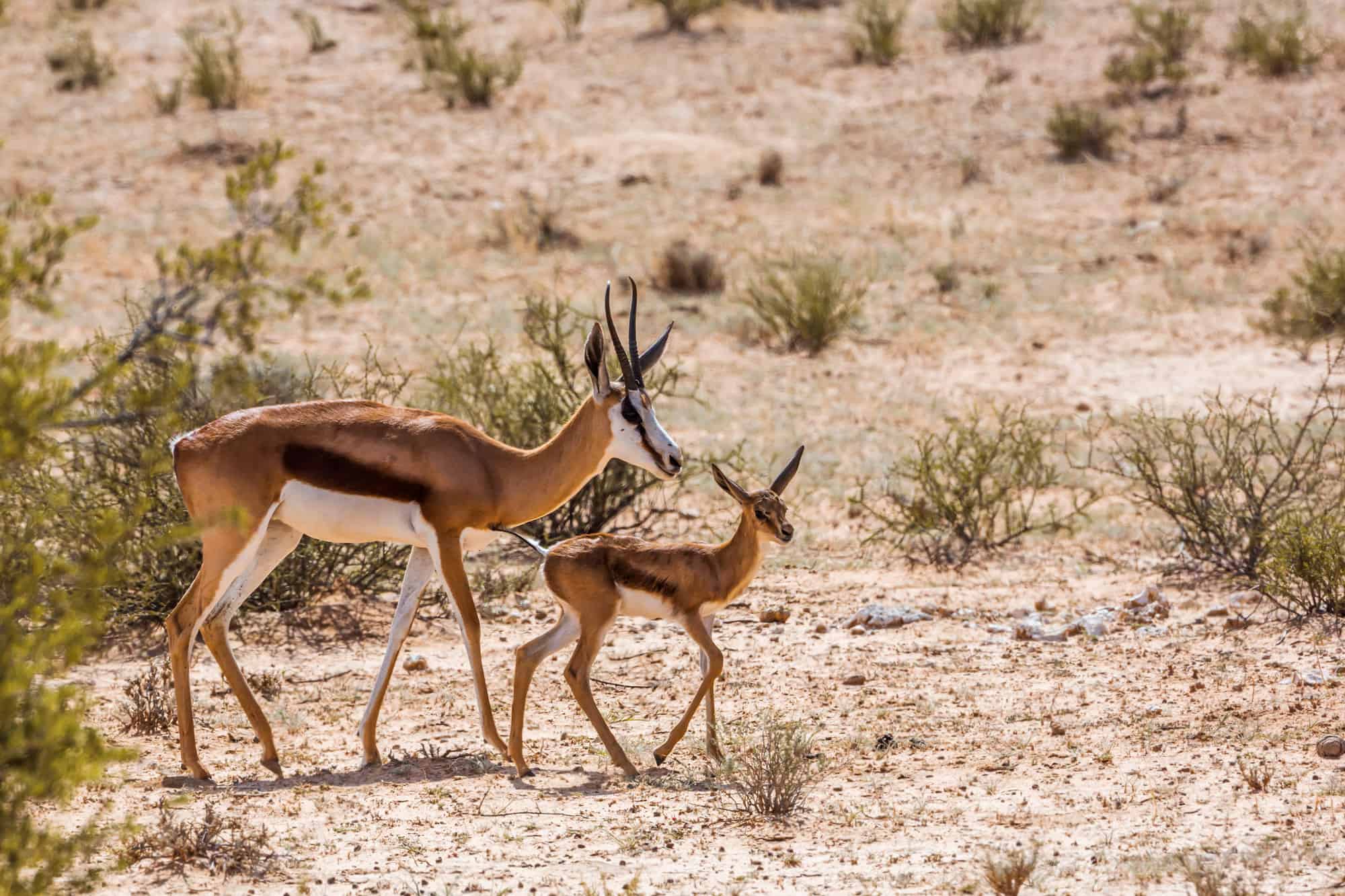
The female springbok is an ewe and her offspring is a calf.
©PACO COMO/Shutterstock.com
Scientific Name
The scientific name of the springbok is Antidorcas marsupialis. This name has nothing to do with the taxonomical group of marsupials hailing from Australia and the Americas. Instead, it comes from the Latin word “marsupium,” meaning a pocket. This refers to the skin flap that the springbok carries along the back.
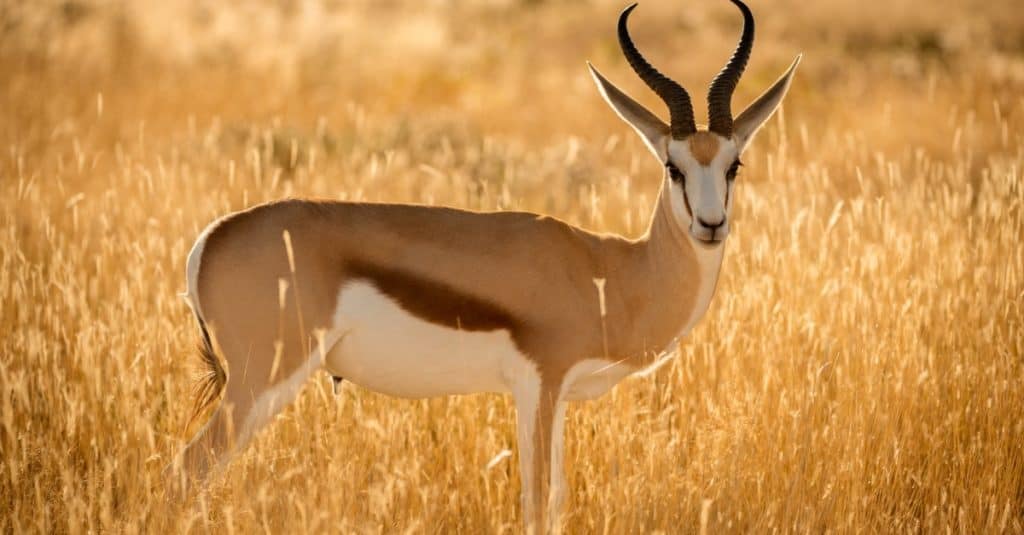
The springbok’s scientific name derives from the Latin “marsupium,” meaning a pocket.
©Udo Kieslich/Shutterstock.com
Evolution and Origins
The springbok belongs to the Bovidae family, which can trace its evolution back to the early Miocene 20 million years ago. The antelope evolved around 3 million years ago, originating from an animal similar to a gazelle.
The springbok is the sole living member of its genus Antidorcas, but other species are known from the fossil record that dates to the Pliocene Epoch. Two Antidorcas species, A. bondi and A. australis, were once common across Africa but became extinct in the early Holocene about 7,000 years ago. A third species, A. recki, is likely a direct ancestor to the springbok and existed around 100,000 years ago during the Pleistocene.
Unlike many animals, springboks do not have a set time period for mating and so the breeding season can occur any time during the year. In this way, they are able to adapt their reproductive timing and respond to changes in their environment’s climate and wait until food sources are readily available and the animals are in top physical condition.
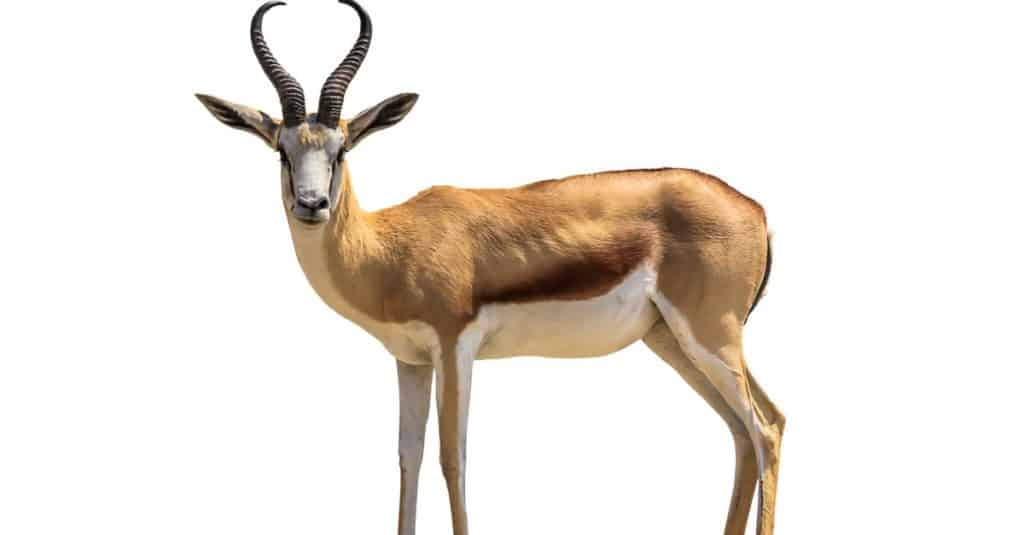
The springbok is the only extant member of the genus
Antidorcas.
©Benny Marty/Shutterstock.com
3 Types of Springboks
There are three recognized subspecies of springboks. There are slight variations in size and appearance, but these subspecies are primarily differentiated by each one representing a different geographical region where they are located.
The subspecies are:
- Angolan springbok (A. m. angolensis): This subspecies can be found in Benguela and Moçâmedes (southwestern Angola).
- Western springbok (A. m. hofmeyri): Present in Berseba and Great Namaqualand (southwestern Africa), its habitat is north of the Orange River and covers Upington and Sandfontein through Botswana to Namibia.
- South African springbok (A. m. marsupialis): These springboks live south of the Orange River, from the Cape of Good Hope to the Free State and Kimberley.
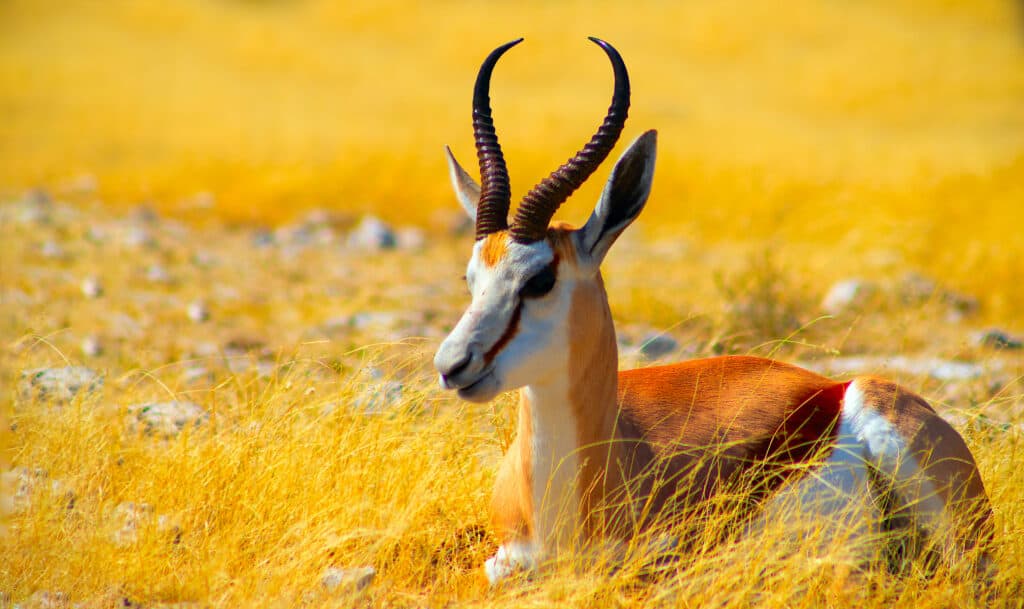
There are three subspecies of springbok, differentiated by the location of their habitat.
©Yulia Lakeienko/Shutterstock.com
Appearance
The springbok has all the physical hallmarks of an antelope, including a long body, slender legs, a V-shaped head, big ears, and huge, ringed horns that curve out and then inward like a stethoscope. These horns are composed of keratin (the substance also found in hair and fingernails), and unlike deer, they are permanently attached to the head and cannot be shed at all.
The springbok’s most distinguishing feature is the skin fold that extends between the mid-back section and the tail. When opened in times of excitement, this fold reveals a crest of white hair. When it’s closed, however, the crest is completely concealed from view.
Most of the springbok’s body is covered with a short reddish-brown coat of hair, while the face, stomach, and interior legs have a white coat sometimes interspersed with dark stripes or markings. Pure black and pure white springboks are also naturally occurring. These variants can be artificially selected and amplified by ranchers who raise springboks for their fur.
Most springboks are about the size of a large dog. They stand no more than 3 feet at the shoulders and weigh anywhere between 60 and 100 pounds. The ringed horns add another 14 to 19 inches to the height of the head. Both sexes are fairly similar in appearance, but males tend to have larger horns and body sizes than females.
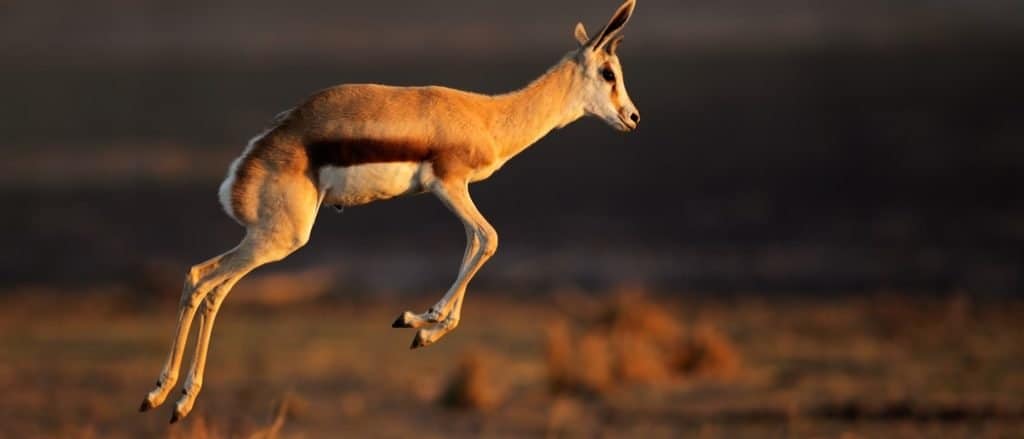
The springbok is around the size of a large dog and is 3 feet high at most.
©EcoPrint/Shutterstock.com
Behavior
The springbok appears to have some kind of a social hierarchy that revolves around large herds which travel together for protection and mating purposes. These herds typically consist of several females, their youngest offspring, and maybe a few dominant males. The remaining males are usually too young or too old to maintain a dominant status, and so they’re relegated to all-male groups, which wander together in search of mates. Springboks once congregated together into mega-herds of thousands or even a million. Since numbers have fallen, these mega-herds have become much less common.
Springboks communicate with each other through a combination of chemical signals, sounds, and body language. Scent markings are believed to play an important role in communication between members of the same species. The dark markings on the body, which they “flash” at other members, may also serve a similar role in communication. Meanwhile, their sense of vision and hearing helps them survive the harsh life on the savanna. The horizontal pupils, with their wide field of view, are very well-adapted for the purpose of identifying nearby potential predators.
One of the more amazing facts is that springboks engage in a jumping maneuver known as pronking (this is an Afrikaans word meaning “to show off”). Pronking occurs when they leap up to 11 feet in the air with their legs stiffened, back arched, head down, and flap opened to reveal the crest of hair. It’s not quite known why they engage in this behavior, but the most common theory is that the springbok is either raising an alarm or attempting to distract a nearby predator. This allows the other springboks enough time to flee.
The springbok’s behavior is heavily influenced by the surrounding ambient temperature of the air. During the hot months, springboks are typically most active during the dawn and dusk hours, when they spend most of their time searching for and consuming food, and then they rest in shade to avoid the hot sun. During the cooler months, however, their feeding times may shift more toward midday.
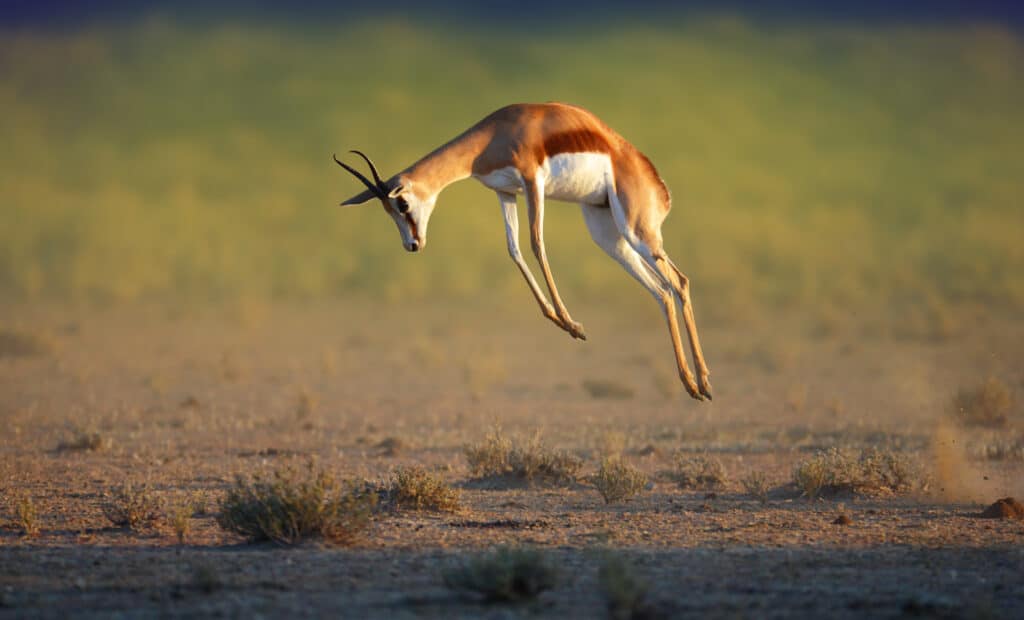
Springboks can leap up to 11 feet in the air when they engage in pronking.
©Johan Swanepoel/Shutterstock.com
Habitat
The springbok can be found all over the southern savannas and deserts of Africa.
The major populations reside in the countries of Namibia, Botswana, and South Africa, where they’re largely confined to farms, parks, and game reserves (including the very popular Kruger National Park). The southern part of Angola has its own separate population.
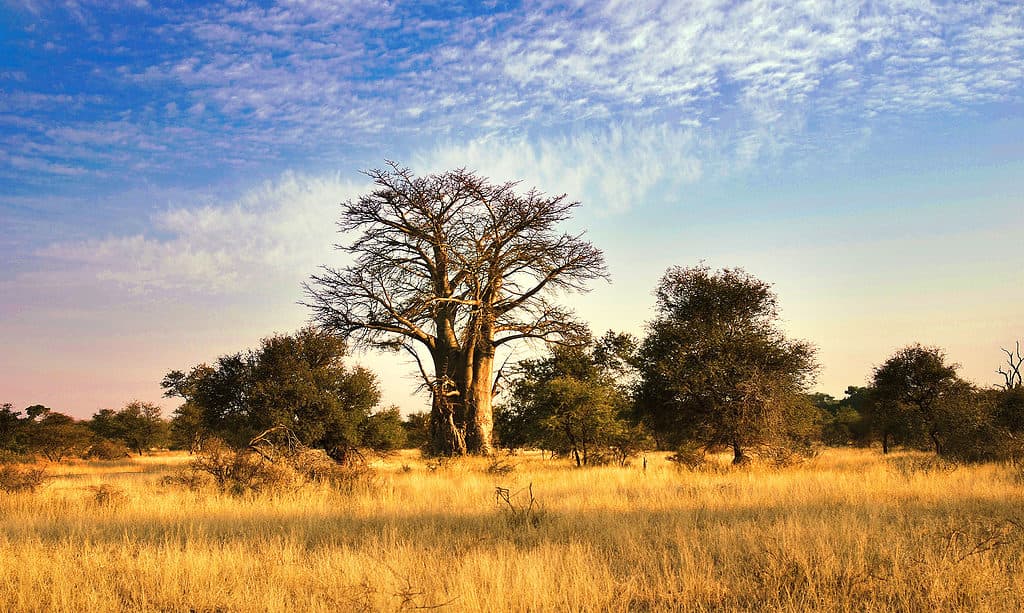
Kruger National Park is a popular spot to see springboks in their natural habitat.
©meunierd/Shutterstock.com
Diet
The springbok is a herbivore; it feeds exclusively on grasses, flowers, and other plant matter. Like other members of the bovid family, the springbok has a complex, multi-chambered stomach to break down tough plant material in its diet.
But its feeding strategies shift between grazing and browsing as the seasons dictate. During the wet season, they consume more grasses. But during the dry season, they browse on flowering plants to obtain both food and water. In fact, springboks derive so much water from their foods that they can sometimes go their entire lives without drinking from springs, rivers, and other large sources of water.
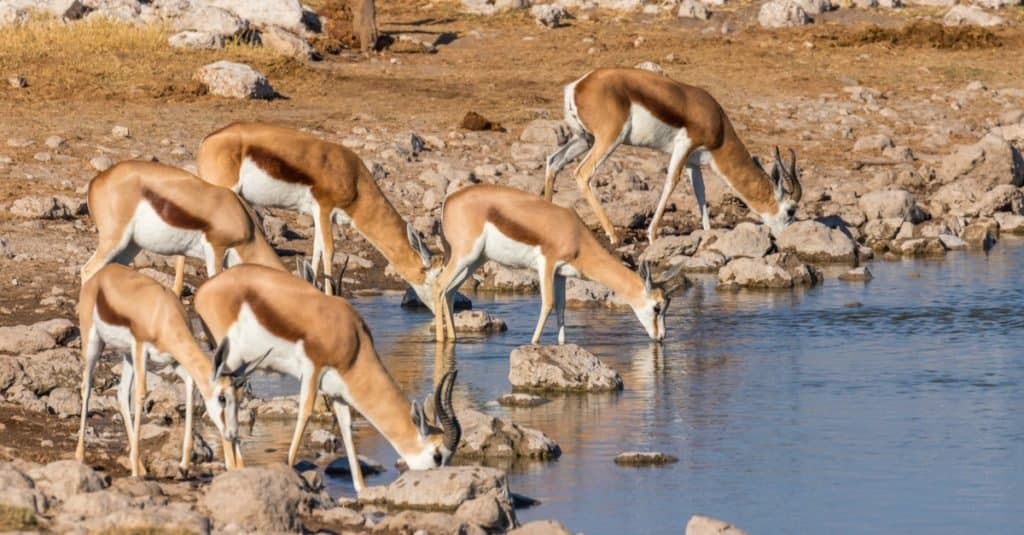
Although springboks derive a lot of water from plant matter, they do drink from waterholes.
©Gunter Nuyts/Shutterstock.com
Predators and Threats
An adult springbok is preyed upon by large predators such as lions, cheetahs, leopards, hyenas, wild dogs, and caracals. The juveniles are also preyed upon by eagles, jackals, and wild cats.
As an important prey species in its natural habitat, the springbok must always be vigilant for nearby threats. Their relationship with humans is particularly complicated. Over thousands of years, they have historically been hunted for their meat and fur. After the arrival of Dutch settlers, farmers considered them to be a nuisance. Because large herds would disrupt and destroy crops, they were hunted more indiscriminately, which caused population numbers to fall.
More recently, after being confined to private farms and game reserves due to habitat loss, they are hunted in a more responsible manner. A license is now needed to kill a springbok on these lands. The cultivation of springbok meat and fur is actually a big business. Their fur is even exported to different countries, while the meat tends to be consumed locally.
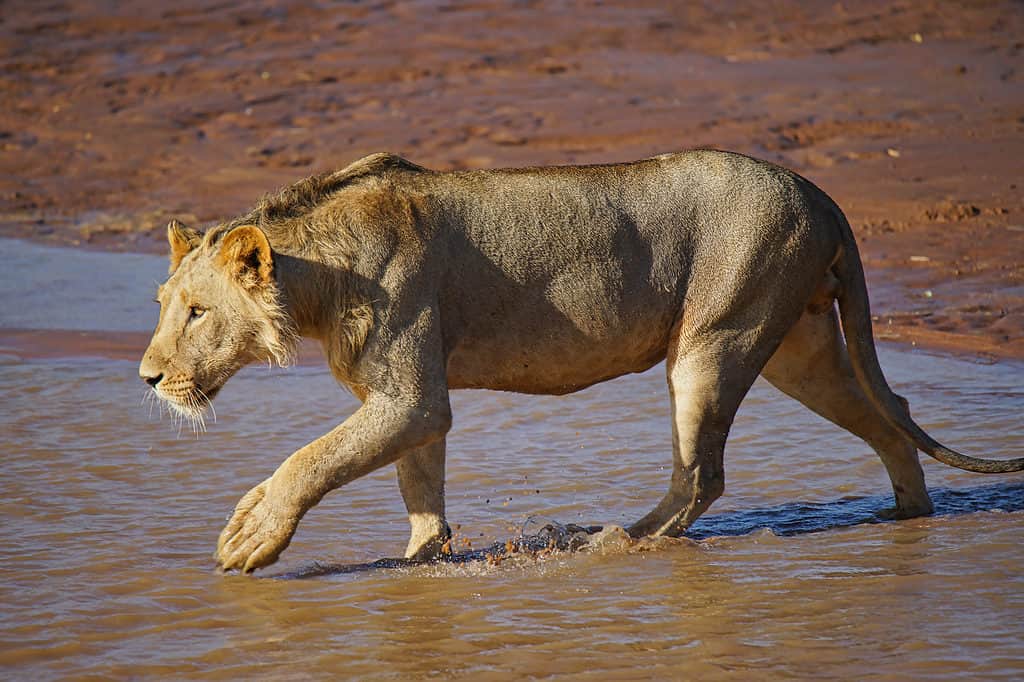
Lions are one of the springbok’s natural predators.
©twabian/Shutterstock.com
Reproduction, Babies, and Lifespan
The springbok’s annual mating season can take place at any time of the year, but it usually proceeds from the end of the wet season, when resources are most abundant and the springbok has achieved its peak physical condition. It then enters a period of sexual excitement known as a rut. During this time, rutting males will defend a territory about 62 to 173 acres large from other males. This will give it exclusive access to any females who are in its territory. Its ritualized displays include loud grunting, a show of the pouch fur, and deposits of urine and dung.
After a four- to six-month gestation period, the female will give birth around the start of the next rainy season in October or November. Due to the time and resources needed to raise the young, she will only produce one or two of them at a time. The mother bears most of the responsibility of caring for the calves. She may join a temporary nursery group, independent from the main herd until the calf is fully weaned off its mother’s milk at around four months of age.
Females are already sexually mature after about 200 days. They tend to stay with the same herd of their birth and reproduce every other year. Males, by contrast, only become sexually mature after 400 days. They tend to wander off and form same-sex groups quickly after becoming independent. Springboks seem to have an average lifespan of seven to nine years in the wild; many will eventually fall prey to predatory animals. But if they manage to survive, then some springboks have been observed to live 20 years.
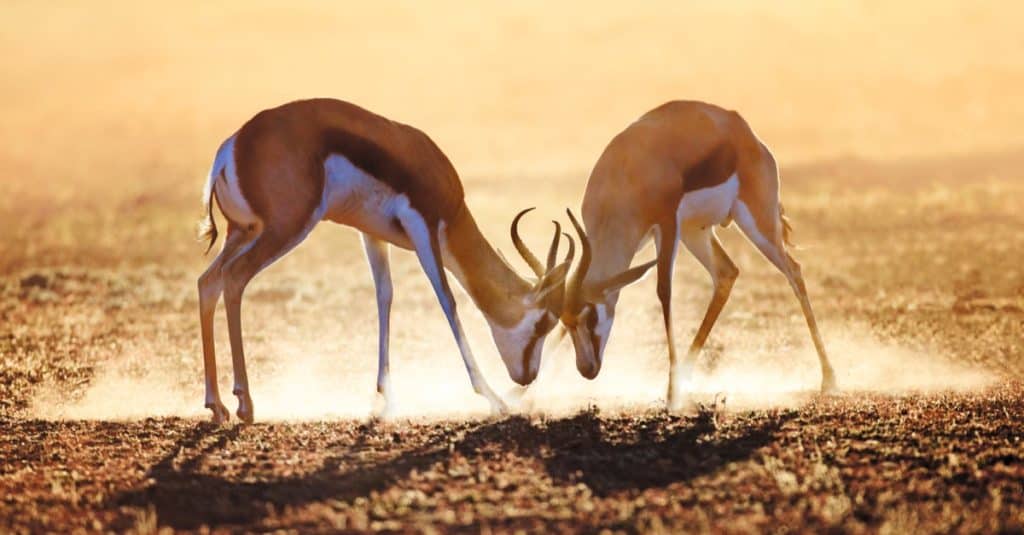
During mating season, a rutting springbok will defend a territory of around 62 to 173 acres by battling another male.
©Johan Swanepoel/Shutterstock.com
Population and Conservation
The springbok is currently considered to be a species of Least Concern by the IUCN Red List.
It is estimated that some 1.5 to 2.5 million springboks still roam the savannas of Africa. While numbers did fall in the 19th and 20th centuries, they appear to be rising again, thanks to robust conservation efforts and a renewed interest in this quintessentially South African species. The preservation of land through reserves and parks has provided a natural refuge for the species to roam with limited human interference.

The IUCN’s Red List categorizes the springbok as Least Concern.
©Tobias Arhelger/Shutterstock.com
Springbok FAQs (Frequently Asked Questions)
What kind of animal is a springbok?
The springbok is a type of antelope – this is one of many species of even-toed hoofed mammals native to Africa and Eurasia. Antelope is a kind of informal miscellaneous category that brings together several closely related species, including the gazelles, addax, impalas, and wildebeests. Together they belong to the family of Bovidae, which makes them closely related to cattle, sheep, goats, and other bovids. While taxonomists do sometimes make a distinction between a “true antelope” (like the springbok and gazelle) and other types of antelope, the distinction is often murky. Scientists still need to gather more facts about their relationship.
Where do springboks live?
Springboks are endemic to the savannas of southwestern Africa, including the countries of Namibia, South Africa, Botswana, and Angola.
What do springboks eat?
Springboks consume plant grasses, flowers, shrubs, and other plant material.
When did the springbok evolve?
The fossil record seems to indicate that early springbok ancestors evolved from a gazelle-like animal some three million years ago.
What are springboks known for?
Springboks are very well-known for their jumping behavior. Jumping appears to occur when the springbok is surprised by a nearby predator.
Thank you for reading! Have some feedback for us? Contact the AZ Animals editorial team.
Sources
- Britannica / Accessed May 29, 2021
- Animal Diversity Web / Accessed May 29, 2021
- San Diego Zoo / Accessed May 29, 2021

